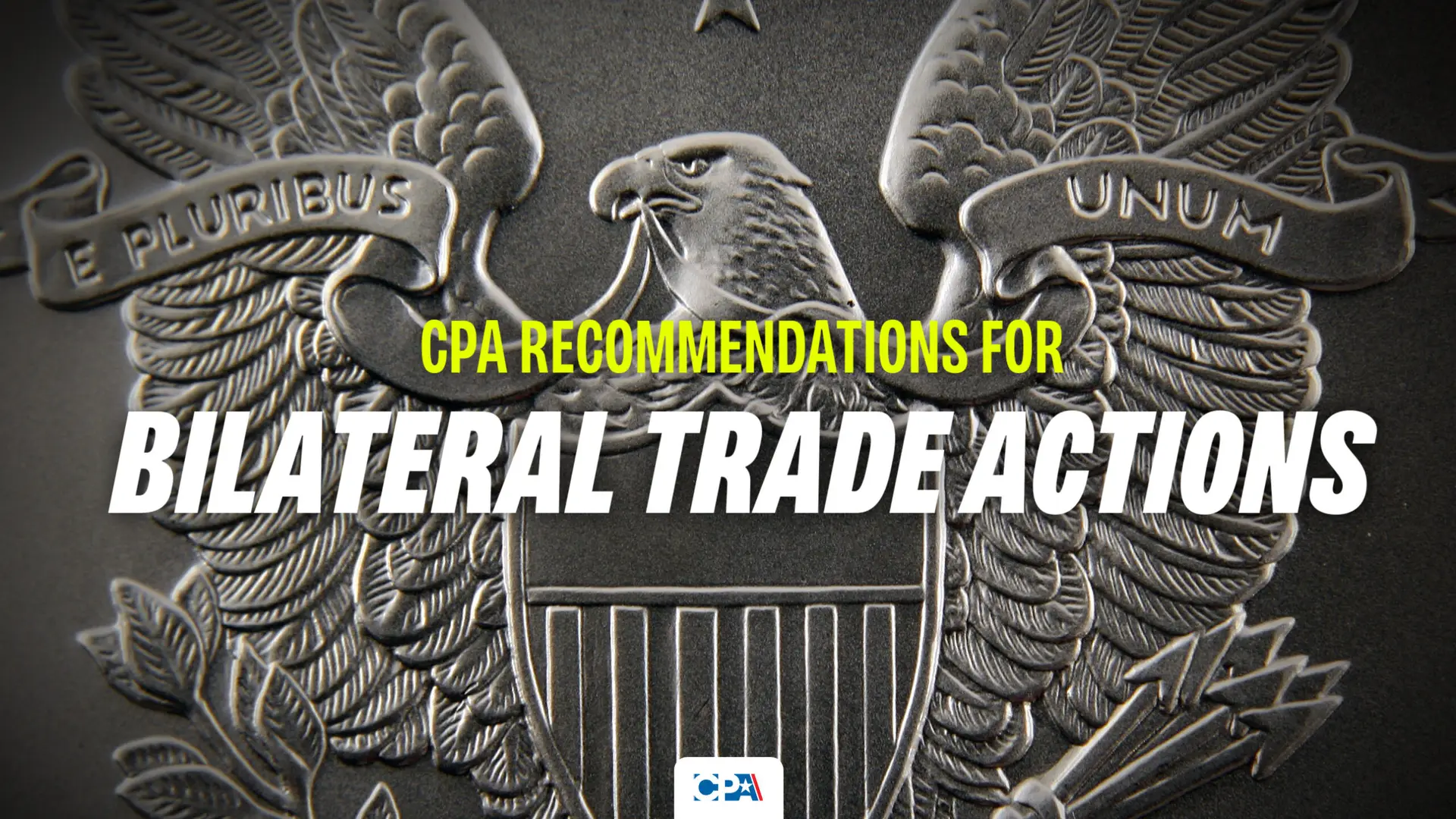Key Points
- The standard widely-used trade model, GTAP, has been wrong in its forecasts of every major U.S. trade agreement.
- CPA economists have modified the model to allow it to show more realistically the effects of trade policy on employment and the entire economy.
- Our modified GTAP model, GTAP-FP, finds that import restriction or policies specifically designed to stimulate domestic U.S. manufacturing investment via tax credits will stimulate the economy, leading to growth in incomes, output, jobs, and investment.
- The typical downsides of tariff policy, inflation and retaliation, are small compared to the benefits of the stimulus.
- The model confirms that manufacturing is a sector with high impact on the rest of the economy
For more than 20 years, the leading economic model of international trade has been used consistently by the U.S. International Trade Commission (USITC) to forecast the impact of free trade agreements and other major trade events on the U.S. economy, jobs, incomes, and production. The findings of this model, known to economists as GTAP, have been quoted by presidents, members of Congress, and other leading political dignitaries.
There’s just one problem. This model’s forecasts have always been wrong. Back in 2001, when China was granted PNTR (permanent normalized trade relations) status and joined the World Trade Organization, economists and Washington think tanks used the model to predict that U.S. exports to China would rise faster than U.S. imports from China. Similarly, when the U.S. signed a trade deal with South Korea, the GTAP model used by the USITC predicted that the U.S. trade deficit with Korea would shrink and this would contribute to U.S economic growth and jobs at home. Instead, the trade deficit doubled and thousands of auto workers lost their jobs.
But the outstanding example of model failure came with model forecasts of the results of the NAFTA trade agreement, published over the course of the 1990s. Tim Kehoe, a professor at the University of Minnesota, adviser to the Federal Reserve Bank of Minneapolis, and longtime expert on trade modeling, wrote in a 2018 paper that after studying ten studies of the NAFTA trade agreement, “the GTAP-AGE model had essentially zero predictive accuracy”[1] (Kehoe’s italics).
The reasons the GTAP model is such a poor forecasting tool are related to those “AGE” initials. They stand for “applied general equilibrium.” GTAP was designed to show economic changes between an economy in equilibrium before a change in trade policy like a trade agreement, and the new equilibrium after the policy changes have brought the economy to a new equilibrium. However, in standard economics, “equilibrium” means when all resources are fully deployed. That rules out the existence of any unemployment. Further, the way GTAP is usually used, it puts restrictions on the addition of new investment capital in the economy. In other words, if auto imports lead to a sudden rise in unemployed auto workers, the model assumes those workers are instantaneously re-employed in other jobs, typically at exactly the same wage as before. The standard model has only two wage levels, one for “skilled” workers and another for “unskilled.”
The result is that cutting the price of a product, including by reducing tariffs, almost inevitably shows growth in national output and jobs. That’s highly unrealistic.
Most economists involved in GTAP modeling freely admit that states of equilibrium do not correspond to real-world outcomes. They point out that GTAP is not a forecasting tool but a teaching tool, designed to highlight specific effects of specific policy actions. But that’s not how the model has been used in Washington, where politicians and economists with an agenda have used it repeatedly to justify trade agreements they wish to promote.
Nevertheless, GTAP remains the best, most widely used, trade model. It is based on data of trade flows between 141 countries, divided into 65 industries. It is “open source” so it can be modified by its users.
At CPA, we believe the model can be made more realistic, and become useful as a forecasting tool. The first steps are to allow production, employment, and capital levels to vary in response to economic shocks such as policy changes. To do that we introduced two new sets of relationships into the standard model.
Our first set of changes involved what we call tariff productivity elasticities. When a tariff reduces the competitiveness of imports, domestic producers can increase production for the home market. For the U.S., the home market is very large. The U.S. consumers some $7 trillion worth of manufactured goods every year. A recent USITC study[2] provided some measures of the increase in domestic production that followed tariffs in 12 industries. The production increases following the tariffs were small but significant in each of the years the USITC studied. See also our previous article[3] summarizing the USITC findings.
Our second set of changes introduce primary factor supply elasticities to the model. Those elasticities allow capital investment, skilled labor, and unskilled labor to rise as the returns to those factors rise (the return to capital is profit and the return to both types of labor is wages). That means that when an industry sees increased demand, it can invest in production and hire more workers. The classic modern real-world example of such a phenomenon is the U.S. steel industry, which is in the midst of investing some $20 billion for new and enlarged production facilities following the 2018 steel tariffs, and hiring thousands more workers.
Taken together, these modifications to the standard model allow GTAP to respond to policy changes with greater flexibility. We call this model GTAP-FP for “flexible production” although more colloquially we call it the CPA Pro-Growth Model because it allows import restriction to lead to economic growth.
Five Scenarios
To illustrate the results of the GTAP-FP model, we ran five simulations or scenarios. First we looked at an aggressive tariff strategy including 35% tariffs on all manufactured imports and 15% on all non-manufactured imports except minerals. We excluded the 20 countries with which the U.S. has free trade agreements, but imposed the tariffs on the entire rest of the world, including China and the European Union. We also looked at this same scenario in the case of equal retaliation against U.S. exports from all countries that were subject to our tariffs.
Next, we looked at Donald Trump’s recent proposal, for a 10% “universal tariff” on all imports from all sources. Again, we looked at the results of that tariff in a scenario where all other nations retaliated with equivalent 10% tariffs on all their purchases of U.S. goods.
Finally, we looked at a scenario in which Inflation Reduction Act-type tax credits contingent on manufacturing investment would be extended to the entire manufacturing sector. We used a tax credit worth 50% of current corporate tax paid. This is also a form of trade policy because it directly stimulates domestic investment and production.
Table 1 shows the key results in all five scenarios. In all cases, the economy grows as a result of the trade policies. The model takes no account of time. It simply compares the equilibrium before the policy implementation and after. A reasonable time period required for this transition to take place is four to eight years.
The growth in GDP is significant in all five scenarios. In every case the stimulus to domestic production generates increases in income, jobs, and investment. The growth takes place throughout the economy, with service sectors growing as they see increased demand from the sectors that are directly stimulated.
The 35/15 tariff plan and the 50% corporate tax credits for manufacturing linked to investment generate similar levels of economic growth, between 6% and 7% at the GDP level. The change in real household income is perhaps the most important variable in Table 1, and in all cases household income grows by over 9% after inflation due to the larger economy boosting wages. In the 35/15 tariff case, household incomes grow by a huge 17.6%. This is due to the stimulus of the manufacturing sector that results from the 35% tariff on imported manufactured goods.
We have shown one of the model’s 20 manufacturing sectors in Table 1, computer and electronics manufacturing. The leap in production of 55.66% is a direct result of the 35/15 tariffs. Other manufacturing sectors also grow, but computers and electronics stands out because it is starting from a small base (the sector is dominated by imports) and it is a high-paying industry, so the stimulus to the economy is very significant.
Modest Inflationary Impact
The rise in consumer prices is modest in all the tariff scenarios, ranging from 0.27% up to 4.51%. This one-time consumer price increase would take place over a transition period of some four to eight years, so the price increase would work out at less than a percentage point a year. Moreover, the increases in real household income are all after inflation, so households see income increases well above the added inflation. In scenario (5), the corporate tax credits, the price increase comes in at just over 8%, which is high compared to an increase in real GDP of 6.3%. This suggests that a 50% across-the-board tax credit may be too high. The GTAP model considers corporate taxes a cost of production, so a reduction in corporate taxes reduces the cost and the price of manufactured goods. That stimulates a substantial increase in demand and household incomes. However, there is real-world evidence that corporate taxes are not treated as a direct cost of production, so the model might need some further fine-tuning to provide a more accurate picture of the impact of corporate tax credits.
The modest impact of the tariffs on inflation is supported by the evidence from the USITC report[4] published in March. That report found that the average price increase in a sector where imports were tariffed was typically between 10% and 20% of the rate of the tariff. A 2021 academic study by four economists including Gita Gopinath of the International Monetary Fund, found even smaller consumer price increases as a result of the Section 301 China tariffs imposed in 2018 and 2019. Looking at some 90,000 products, 36,000 of which were impacted by China tariffs, they found tiny consumer price increases were attributable to the tariffs. “The results…imply that in response to a 10 percent tariff, the price of a typical affected import from China has only increased by about 0.35 percent relative to unaffected products in the same sector after 1 year,”[5] they wrote.
Impact of Retaliation Surprisingly Small
The 10% tariffs deliver U.S. economic growth that is just under half that of the 35/15 scenario. That’s not surprising. The tariffs are only 1/3 as large, but they are applied to worldwide imports instead of just those from non-free trade agreement countries.
However, the impact of retaliation in both the 35/15 scenario and the 10% scenario is surprisingly small. In both cases, the retaliation reduces U.S. exports and dampens growth, but growth falls by only 1 percentage point in the 35/15 case and 2/3rds of a percentage point in the 10% case. In fact, in the 10% case with retaliation, household incomes actually rise by one percentage point more than in the 10% with no retaliation case! The reason for this is that each stimulus to the economy creates demand for additional home production. That demand is met by a combination of increased production and increased prices. We have chosen large tariffs and tax credits, and they deliver significant boosts to both production and prices. The retaliation reduces demand for U.S. exports and this moderates the impact of the stimulus. That eases the pressure on price increases. Smaller price increases allow household income to grow more because households benefit from increased wages and other income while prices grow somewhat less.
If policymakers were to choose either of these policies (tariffs or tax credits linked to domestic investment), the degree of the stimulus should be carefully chosen to ensure that most of the benefit goes into increased production rather than prices. The ability of any sector to respond to a demand stimulus depends on available resources within each sector. Our model’s parameters are customized by sector. Nevertheless, the GTAP model does not provide deep characterization of each sector of the U.S. economy. So these policy options should be regarded as broad indications of the impact of these policies, not precise recommendations.
Table 1. CPA model results. U.S. economy grows in all five scenarios
| (1) 35/15 Tariffs | (2) 35/15 + Retaliation | (3) 10% Tariffs | (4) 10% + Retaliation | (5) Corp Tax Credits | |
| Real GDP (%ch.) | 6.95% | 5.91% | 3.61% | 2.97% | 6.30% |
| Employment (change, M) | 7.3M jobs | 6.2M jobs | 3.3M jobs | 2.5M jobs | 11.2M jobs |
| Real Household Income (%ch.) | 17.6% | 10.72% | 10.43% | 11.46% | 9.15% |
| Real Mfg Output (%ch.) | 16.31% | 18.49% | 3.29% | 6.06% | 46.88% |
| Computer/Electronics Mfg Output (%ch.) | 55.66% | 36.59% | 31.98% | 26.05% | 13.99% |
| U.S. Tax Revenue (change, $B) | $921.5B | $799.2B | $460.3B | $404.5B
|
$226.1B |
| Consumer Price Index (%ch.) | 4.51% | 0.27% | 3.82% | 1.01% | 8.03% |
| Real Imports (%ch.) | -8.39% | -19.76% | -7.48% | -15.93% | -0.97% |
| Real Exports (%ch.) | -2.95% | -21.97% | -7.28% | -21.24% | 19.27% |
Conclusion
Our modified GTAP model, GTAP-FP, finds that import restriction or policies specifically designed to stimulate domestic U.S. manufacturing investment via tax credits will stimulate the economy, leading to growth in incomes, output, jobs, and investment. The typical downsides of tariff policy, inflation and retaliation, are small compared to the benefits of the stimulus. The model confirms that manufacturing is a sector with high impact on the rest of the economy because of its impact on the entire supply chain and because the market share lost to imports in recent years provides a large opportunity to regain market share, with benefits for workers, businesses, and ultimately consumers too.
The CPA innovation in the GTAP model shows that the standard GTAP model is heavily biased against activist trade policy. However, GTAP contains thousands of valuable data points and economic relationships expressed as equations. Introducing a small number of new relationships into the model can make the model more realistic and a better forecasting tool. More work is needed to improve the model further. A model on its own is not and should not be the sole determinant of the best economic policies. It is a guide and a valuable indicator of the effects of policy choices, including often unexpected effects. As such it should always be used with caution.
[1] Timothy J. Kehoe, Improving the Analysis of Trade Policy, Federal Reserve Bank of Minneapolis Economic Policy Paper, Jan. 23, 2018. Available here.
[2] U.S. International Trade Commission, Economic Impact of Section 232 and 301 Tariffs on U.S. Industries, March 2023, Revised May 2023. Available here.
[3] Jeff Ferry, USITC Report Shows Tariffs Boosted U.S. Production, Sept. 15, 2023, Available here.
[4] U.S. International Trade Commission, op. cit.
[5] Alberto Cavallo, Gita Gopinath, Brent Neiman, and Jenny Tang, Tariff Pass-Through at the Border and at the Store: Evidence from US Trade Policy, American Economic Review, Insights 2021, pg. 29.












